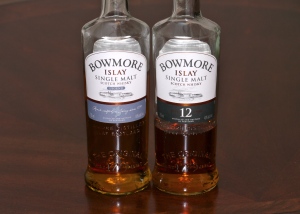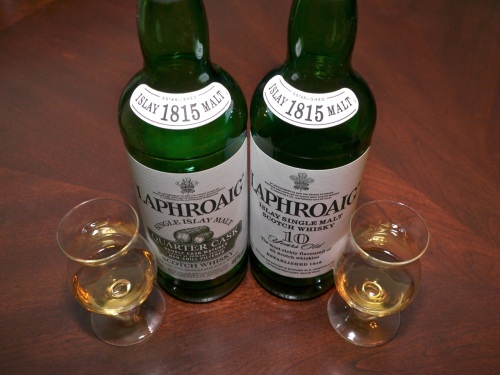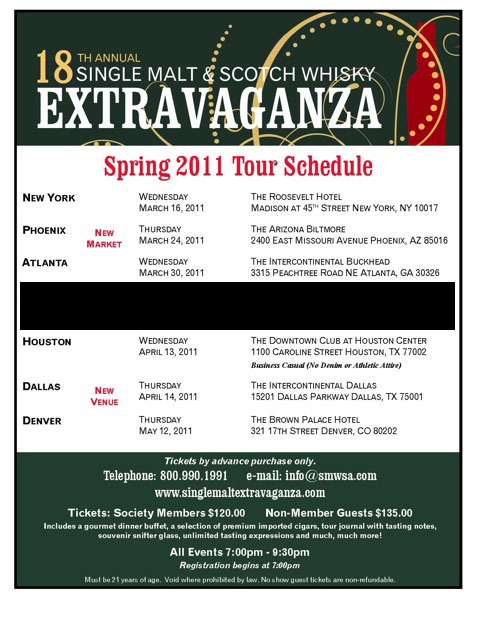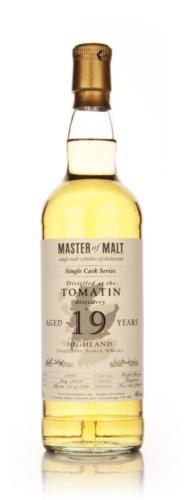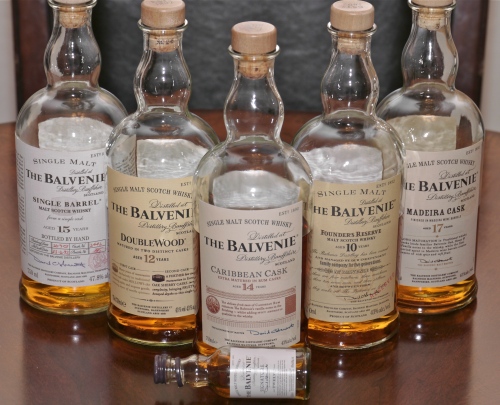Introduction
Fancy yourself a whisky connoisseur? I don’t – not yet, anyway. However, I do obviously spend a fair amount of time reading about and tasting whisky. But has all of this focused effort led to any kind of improved ability to discern whisky expressions by taste, smell and color? I’m not sure a single blind tasting is any way to determine that, but from what I’ve read of them, it’s a good way to gain some perspective, and perhaps a little humility. I’m game for that.
My local Single Malt Scotch Society (which I just discovered a year ago) periodically does blind tasting meetings, and I just recently attended my first one. This is a great group to drink and discuss single malts with. They’re much more experienced than I am, some of them being members of PLOWED, so it’s great to hear about the world of whisky from their point of view. Fortunately, it’s a laid back group, and the primary goal is to have a good time, not impress each other with our tasting prowess.
Let the games begin…
Rules of the game
There were 9 of us in attendance. We received a cheat sheet ahead of time listing 13 possible expressions. Of those 13, 10 would be chosen at random by a non-participant (the brother of John, our leader and host). Those 10 were to be poured into jars and numbered. The name of the malt was written on a card and placed in an envelope with the appropriate matching number.
The cheat sheet
Islay malts
- Ardbeg Airigh Nam Beist 1990, 16 yr., OB, 46%
- Lagavulin 16 yr., OB, 43%
- Laphroaig 18 yr., OB, 48Q%
Speyside malts
- Balvenie DoubleWood, 12 yr., OB, 43%
- BenRiach 1994 Peated Oloroso Sherry Finish, 12 yr., OB, 57%
- Cardhu 12 yr., OB, 40%
- Glenfarclas 25 yr., OB, 43%
Highland malts
- Ben Nevis 1986, 14 yr., Cadenhead bottling, 62.9%
- Clynelish 14 yr., OB, 46%
- Highland Park 18 yr. OB, 43%
Campbeltown malts
- Springbank 15 yr., OB, 46%
Lowland malts
- Auchentoshan Three Wood, NAS, OB, 43%
- Rosebank 1990, 14 yr., Whisky Galore bottling, 46%
Upon arriving…we were each given a scorecard to fill out. For each malt, we would fill in the information below. You can get up to 10 points per malt. The winner earns bragging rights in the next society newsletter.
Scorecard breakdown:
- Region (3 pts): Multiple Choice from:
- Islay
- Speyside
- Other Highland
- Lowland
- Age (2 pts)
- 12 yrs or less
- 13-17 yrs
- 18+ yrs
- Strength (1 pt)
- 40%
- 43%
- 46%
- Above 46%
- Cask type (1 pt)
- Bourbon only
- Sherry
- Other Finish
- Distillery (3 pts)
The Tasting
Malt #1 – BenRiach 12 year
My Scorecard: Speyside (3 pts); 12 yrs (2 pts); Above 46% (1 pt); Other Finish (0 pt); BenRiach (3 pts) – Total 9 pts
Comments: A sherry and peat combination came through clearly. Fortunately, I have tasted a couple of other BenRiach peated whiskies (and own one). There’s something distinctive about the BenRiach flavor of peated whisky (at least their finished ones) that just stood out right from the start. I questioned myself at first, as the cheat sheet didn’t say this was a “peated” BenRiach, but I decided to go with my gut. I’m glad I did! Unfortunately, I screwed up the scorecard on this first one. I put “Other Finish” because it is a “finished” whisky. The correct answer was “sherry.” Basically…I didn’t follow directions.
How I’m feeling (after the reveal): At this point, I’m thinking “hey…I’m going to completely kick ass at this!”
Malt #2 – Rosebank 1990 14 year
My Scorecard: Other Highland (0 pt); 13-17 yrs (2 pts); 46% (1 pt); Bourbon (1 pt); Clynelish (0 pt) – Total 4 pts
Comments: I took one whiff of this, a quick sip, and immediately wrote down that it was the Clynelish. I thought it had kind of a rough and tumble highland flavor that I associate with Clynelish, and I decided to go with my initial instinct. It worked with the BenRiach. A swing and a miss, but the catcher dropped the ball, so I was able to run to first. While I completely missed this one, the age, strength and cask type just happened to match.
How I’m feeling: “Doh! Coming back down to earth, but hey…I’m not familiar with the Rosebank. It just fooled me. I’ll get the next one.” I don’t know if it was because it immediately followed a peated whisky, but most of us were totally surprised to find out this was a Rosebank.
Malt #3 – Clynelish
My Scorecard: Speyside (0 pt); 12 yrs (0 pt); 40% (0 pt); Bourbon (1 pt); Cardhu (0 pt) – Total 1 point
Comments: I was completely stumped on this one. It seemed easier going than the previous dram (Rosebank), so I started down the Speyside track (I think I had Clynelish mentally blocked out because I had just guessed it on the previous dram). I also heard other comments in the group about it being smooth and easy. Only one of the four Speysides looked like it might have only a bourbon cask maturation…Cardhu. Well, it doesn’t seem as smooth and sweet as I’ve heard Cardhu described, but then, I’ve never had it before. A total guess on my part.
How I’m feeling: At this point, I’m thinking “hey…I completely suck at this!”
Malt #4 – Glenfarclas 25
My Scorecard: Other Highland (0 pt); 18+ yrs (2 pts); 43% (1 pt); sherry (1 pt); Glenfarclas (3 pts) – Total 7 pts
Comments: This one tasted a lot like the Glenfarclas 17 year to me, which I’m quite familiar with. However, I expected the 25 year to have a bigger “classic sherry” taste to it. Still…it seemed distinctly Glenfarclas. As we bantered a bit as a group, it seemed like a number of others thought it was HP 18. I couldn’t buy into that, but then, I was completely wrong on the last two. Ok…hedging my bet and going Glenfarclas, but putting “Other highland” for the region, just in case.
How I’m feeling: “Whew! Back in the game!” Although, my failure on the previous two kept me from fully committing. Oh well…I’d take 7s the rest of the way, no problem.
Malt #5 – Lagavulin 16
My Scorecard: Islay (3 pts); 13-17 yrs (2 pts); 46% (0 pt); sherry (1 pt); Ardbeg (0 pt) – Total 6 pts
Comments: This was obviously one of the three Islays. The color was darker than I remember either the Ardbeg ANB or the Laphroaig 18 being. However, I KNOW Laga 16. It’s one of my favorites. I’m not getting that certain iodine/fruit combination that I know and love from the Laga. Hmm…I know his bottle of ANB is 16 years vs. my 18 year bottle. Maybe it’s a little bigger with less vanilla at 16 years (at this point, my mind is playing games, and I’m forgetting about how dark the whisky in my glass is). Ok, if this was Laga 16, I would just “know it”, so I’m going to hedge my bet between ANB and Laga 16. At least they’re the same age, so I should get the region and age right, regardless.
How I’m feeling: I thought I’d be happy with 6 or 7 points, but…“I’m feeling like a complete fraud for not being 100% sure that this was Lagavulin 16, supposedly one of my favorites, and one I’m most familiar with. On top of that, I’m an idiot for not paying more attention to the color.” I felt a little better to find out this was an older bottle, and has been open for a number of years. That might play into it a little. Still…
Malt #6 – Highland Park 18
My Scorecard: Other Highland (3 pts); 18+ yrs (2 pts); 43% (1); Sherry (1 pt); HP (3 pts) – Total 10 pts
Comments: Sherry for sure, with a little peat, but not Islay peat. I hear a couple of people talking Ardbeg/Laphroaig. No way…I know this one. I’m going all in on HP 18, and feeling good about the fact that our host, John, just indicated that he feels the same way.
How I’m feeling: Back from the brink. “Ok…the whisky gods threw me a bone on this one. It’s good to know I can pick out at least ONE of my favorites.”
Malt #7 – Cardhu
My Scorecard: Speyside (3 pts); 13-17 yrs (0 pt); 40% (1 pt); sherry (0 pt); Springbank (0 pt) – Total 4 pts
Comments: Doh! I really let the group banter get to me on this one. After an initial sip, I checked “Speyside” on the card. Now I just had to figure out if it was Cardhu (which I’ve never had) or Balvenie. We then took a break mid-dram to get some food, as our palates were starting to get tired.
After taking a break, drinking some water and eating a few potato chips, I returned to taste some more. I heard others talking about Springbank. Hmm…maybe that sweetness on the close was a sherry cask sweetness. It didn’t taste like Balvenie, though. Maybe it was turning salty…or was that the potato chips? Time up – everybody else has marked their cards. I decide to quickly do a 3-way hedge between Cardhu, Balvenie and Springbank.
How I’m feeling: Like Charlie Brown: Wishy-washy. Sigh…
Malt #8 – Balvenie DoubleWood
My Scorecard: Lowland (0 pt); 12 Years (2 pts); 43% (1 pt); Sherry (1 pt); Auchentoshan (0 pt) – Total 4 pts
Comments: It seemed obvious on this one that it was either the DoubleWood or the Three Wood. I heard others debating the same thing. I’ve only had a single dram of the Auchentoshan before, and I remember it stood out as being very “woody”…more so than I expected from a NAS expression. Well, this one immediately struck me as being woody as well, and it just didn’t quite seem to have that Balvenie honey/apple combination that I THOUGHT I could easily recognize. I didn’t dare look at Adam on my right…he’s a big “Balvenie guy”, and I knew he’d probably be beaming if this was the DoubleWood. I wanted to get this on my own, though. I’m going with the Three Wood.
How I’m feeling: “Doh! (again)” I’m taking it all more in stride, though. It’s become clear that nobody in the group is able to nail these expressions consistently. Heck, even Adam (who sure enough got this one right) admitted that his taste buds are shot and it was the color that he thought gave this one away.
Malt #9 – Ben Nevis 1986 62.9%
My Scorecard: Other Highland (3 pts); 13-17 yrs (2 pt); ABOVE 46% (1 pt); Bourbon (1 pt); Ben Nevis (3 pts) – Total 10 pts
Comments: Everybody nailed this one. This was the only high ABV whisky left on the cheat sheet. It was very good, though.
How I’m feeling: “I just coated my tongue with 62.9% of Highland goodness. Will I be able to taste #10?”
Malt #10 – Surprise…Laphroaig 30 Year!
My Scorecard: Islay (3 pts); 43% (2 pts); 18+ years (1 pt); Sherry (1 pt); Bowmore? (0 pt) – Total 7 pts
Comments: For this last dram, we had a surprise “off the cheat sheet” whisky. John and Richard disqualified themselves (Richard supplied the bottle). We knew, once they announced this, that it was something special (and it was). Up front, there was a gentle but prominent peat, but it lacked the big medicinal, tarry, oily notes you would get from a younger Laphroaig or Ardbeg. It reminded me of my favorite Laphroaig 30 year, but if that was the case, I would expect more red fruits to come out at the end. This one had some wonderful dried fruit notes, but I didn’t get any ripe berries. Certainly, this was an older (25+ years) whisky, and the proof was relatively low.
A few others speculated about the Distillery, with Bowmore mentioned more than once. I suddenly had visions of having the opportunity to taste one of the famous older Bowmores (Black, gold, etc.). Hey, with this group, I wouldn’t be surprised if somebody owned something of that caliber.
How I’m feeling: “Oh, come on! This is supposed to be my all time favorite whisky and I couldn’t nail down the taste profile?” Oh well..at least I didn’t think it sucked! In fact, it was so good, I elevated it beyond Laphroaig 30 status and tried to figure out which famous, all but unobtainable whisky it might be.
Total: 62 points.
Conclusion
We added up our points, and believe it or not, I was tied for first at 62 points with Adam! Not so fast, though…after pumping my fists in the air, I realized that with Richard reporting 61 points, but taking a disqualification on the Laphroaig 30, he was clearly the #1 blind taster. Second would be John, who scored 55, but would have had 62 to 65 if he could have gotten points for the Laphroaig. Even with a point tie, I would put John before either of us, as I was “playing the game” and hedging bets, and Adam openly admitted to simply “guessing” the last 4 correctly after his taste buds were shot and his allergies bugging him.
I think a lot of the remaining tasters scored in the 40s, but when you take into account that many were going all in on their guesses (not hedging their bets), there were probably quite a few 1 point scores, even though they may have been close to guessing correctly. I’m also not sure how seriously everybody took it. I will admit, though, that I really, really tried. I was jumping up in between drams and blasting my glass with water in the sink and wiping it with a fresh paper towel, making sure it was as clean as possible. Michael, one of the long time society (and PLOWED) members was laughing at me…saying he used to be the same way. Today, he was just having a great time…he had nothing to prove.
So, what is my takeaway? Trying to guess a whisky based on a blind test is hard! Even if the field is narrowed. However, based on the few successes I had, and realizing how my mind played with me on some of the failures, I DO think there is room for a certain amount of olfactory training when it comes to recognizing distillery profiles. I look forward to practicing more blind tasting at home, and participating in another group event in the future.
How well do you think you know your favorite whisk(e)y, wine, beer or other spirit? Try putting yourself to the blind test to find out…the results may surprise you!
Cheers, Jeff
